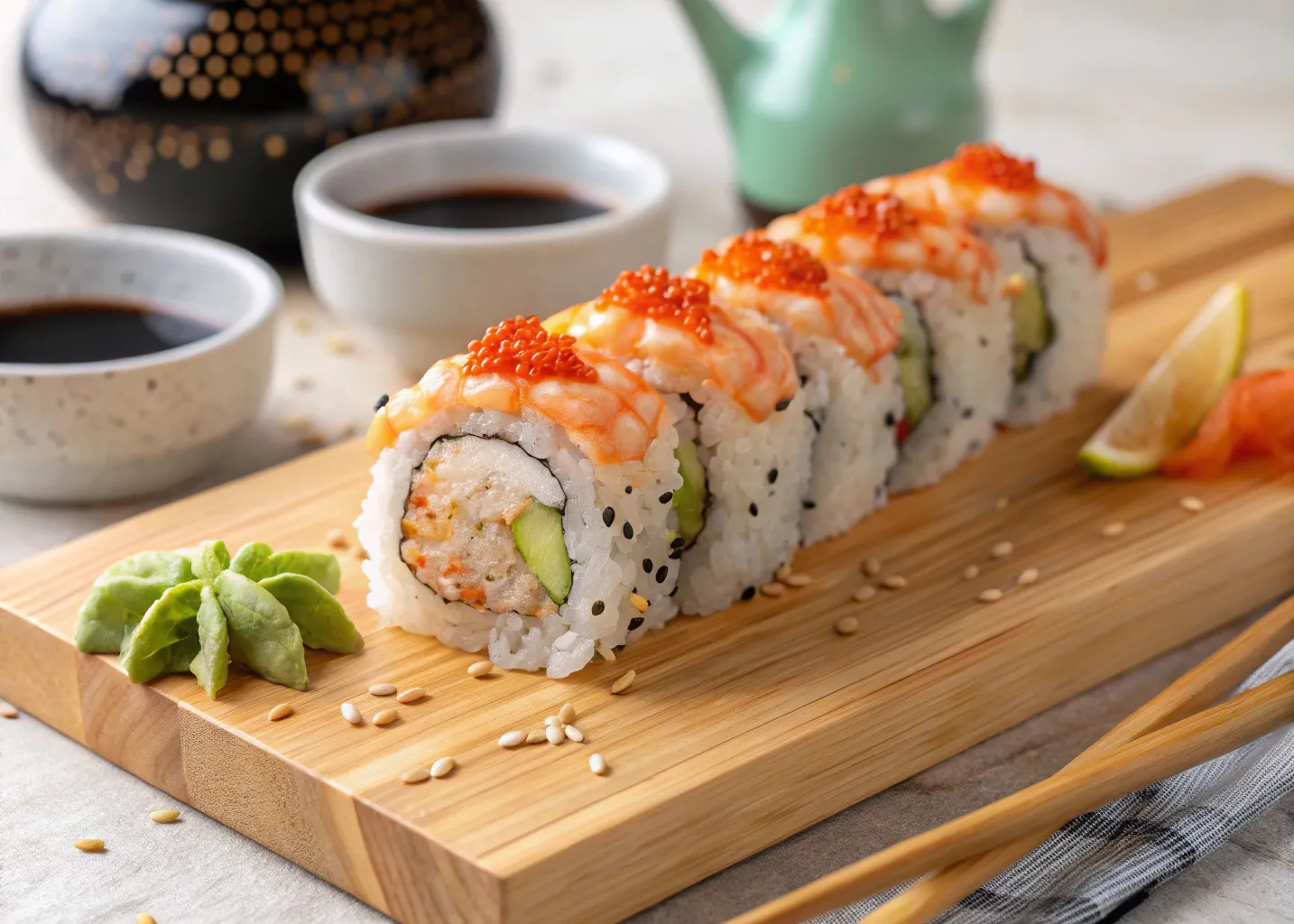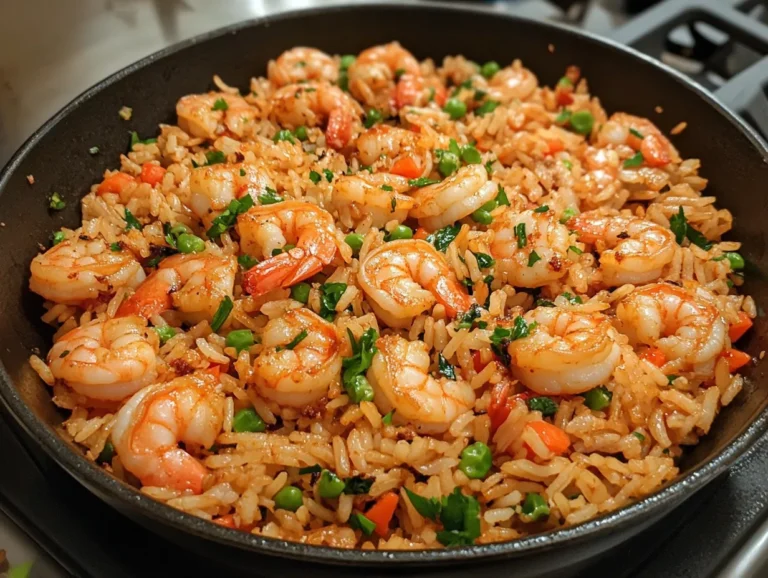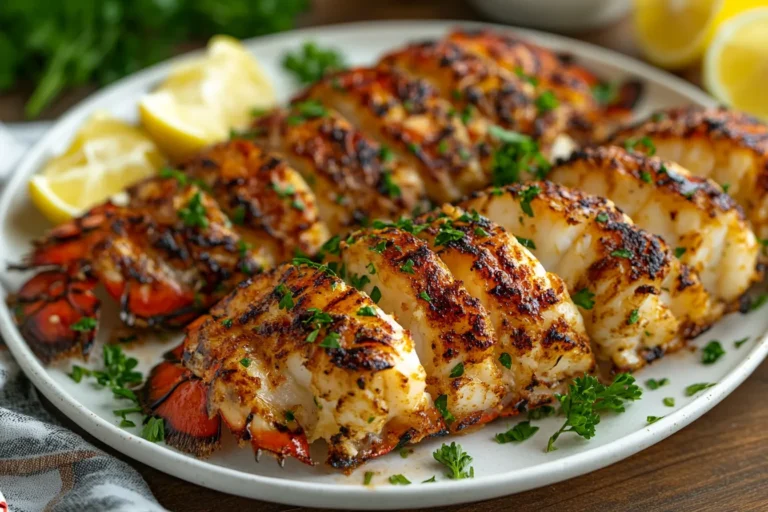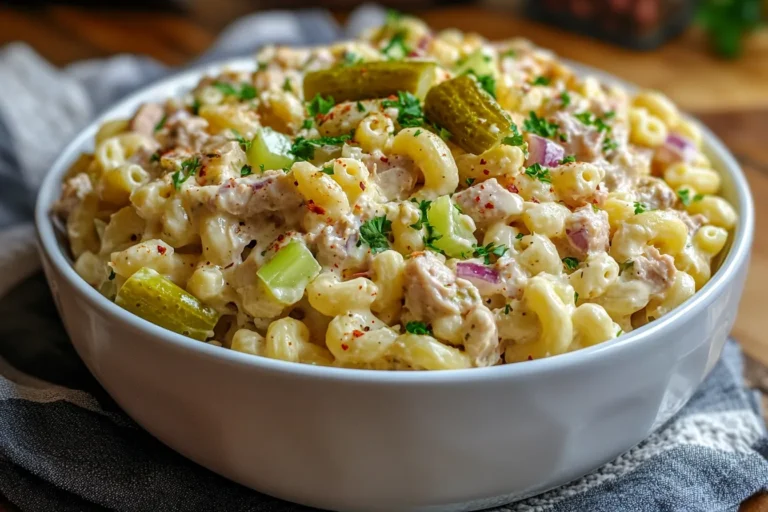Shrimp tempura roll isn’t just another sushi option — it’s a crunchy, savory fan-favorite that blends traditional Japanese flavors with modern twists. Whether you’re new to sushi or a seasoned chopstick pro, this roll stands out for its crispy tempura shrimp, creamy avocado, and delicious sauces layered into one satisfying bite.
Not sure what’s in a shrimp tempura roll? Wondering if it’s fully cooked, or what those orange pearls on top are? This guide answers it all — from ingredients to etiquette, nutrition to variations. Shrimp tempura roll is more than just sushi — it’s a gateway for many into the world of Japanese cuisine.
Craving more shrimp dishes beyond sushi? Try our Shrimp Fried Rice Recipe for another bold, comforting favorite with cooked shrimp and umami-packed flavor.
Discovering the Shrimp Tempura Roll
What Makes Shrimp Tempura Rolls Stand Out in Sushi Menus
Sushi menus can be overwhelming, especially if you’re not into raw fish. That’s where shrimp tempura rolls shine. With fully cooked shrimp fried in a light tempura batter, wrapped in seasoned rice and seaweed, these rolls deliver a crispy, comforting texture that appeals to just about everyone — even sushi skeptics.
You’ll find them in almost every sushi bar in the U.S., often listed under specialty rolls or crunchy rolls. The appeal? Shrimp tempura rolls strike a balance: they’re indulgent without being intimidating.
How This Roll Became a Popular Japanese-American Fusion Favorite
While tempura dates back centuries in Japanese cuisine, the shrimp tempura roll is a modern invention — born out of the fusion between traditional sushi and American tastes. In the U.S., diners preferred cooked fillings and bold flavors. Sushi chefs responded with this genius combo: crispy fried shrimp wrapped in a roll, often with avocado, cucumber, and drizzles of spicy mayo or eel sauce.
Today, it’s one of the most ordered rolls across North America. You’ll even see variations like the Dragon Roll or Tempura Crunch Roll — all branching from this one delicious origin.
Ingredients That Build a Shrimp Tempura Roll
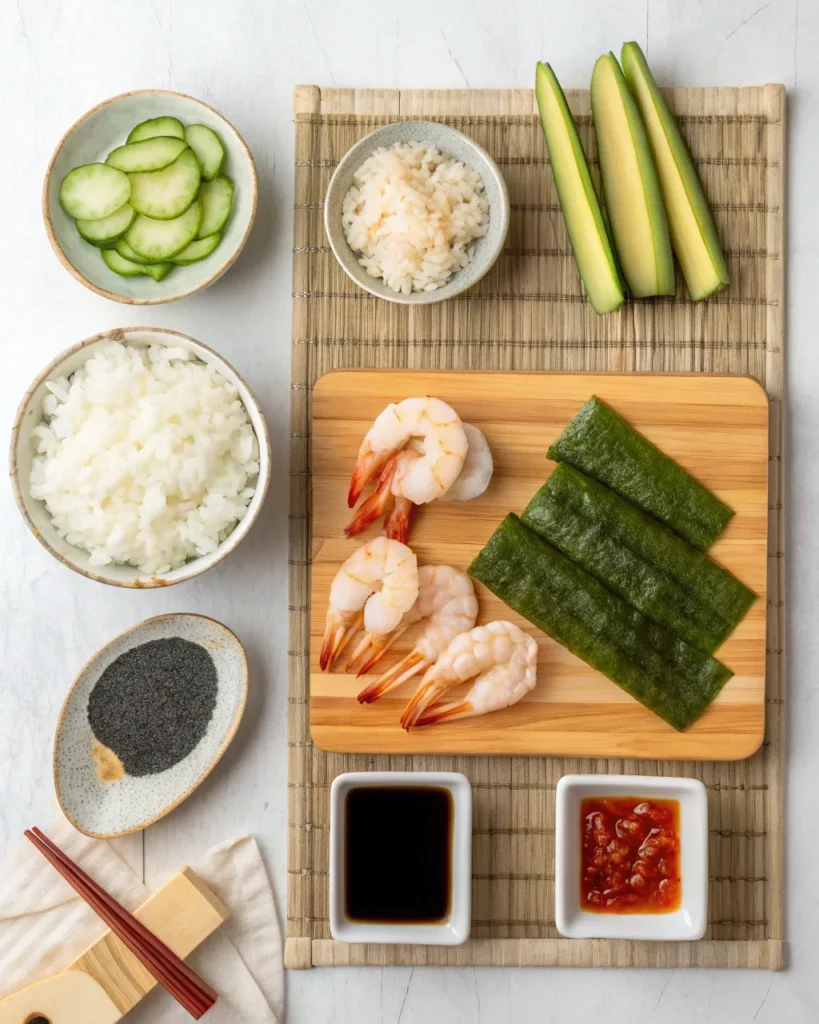
Crispy Tempura Shrimp: The Heart of the Roll
At the core of every shrimp tempura roll is one star ingredient — tempura shrimp. It’s not your average fried shrimp. The batter is light, airy, and crisp, made from a mix of flour, egg, and ice-cold water. This Japanese technique gives the shrimp a golden, crackly shell that holds up beautifully even after rolling.
Most sushi chefs use large tiger shrimp or jumbo shrimp, deveined and straightened before frying. Once cooled, it’s carefully placed on a bed of sushi rice and wrapped in a sheet of nori (seaweed).
What makes this roll different from others? It’s fully cooked, so it’s ideal for sushi beginners or those avoiding raw seafood. The tempura texture also adds a satisfying crunch that’s missing in most traditional rolls.
Common Add-ins: Avocado, Cucumber, Cream Cheese & More
While the shrimp takes center stage, the supporting ingredients bring flavor and balance. The most common additions include:
| Ingredient | Role in the Roll |
|---|---|
| Avocado | Adds creaminess and smooth texture |
| Cucumber | Brings a cool, refreshing crunch |
| Cream Cheese | Optional — creates a rich, savory contrast |
| Spicy Mayo | Delivers heat and cream in every bite |
| Eel Sauce (Unagi) | Adds sweetness and umami to the topping |
Some rolls even go a step further with toppings like masago (tiny orange fish eggs), crispy tempura flakes, or a light drizzle of sesame oil. These toppings enhance flavor and give each bite a layered texture.
The shrimp tempura roll is also versatile. Chefs often play with combinations like mango, jalapeño, or lettuce to give it a unique regional twist.
Understanding How It’s Made
Step-by-Step Sushi Roll Assembly with Tempura
Making a shrimp tempura roll might look complicated, but the process is quite straightforward once you understand the layers. Whether you’re enjoying it at a sushi bar or making it at home, each component is placed with care to achieve the right balance of taste, temperature, and texture.
Here’s how the roll comes together:
- Prepare the Sushi Rice
Sushi rice is a short-grain variety that’s seasoned with vinegar, sugar, and salt. It’s sticky enough to stay together without becoming mushy. - Lay Down the Nori
A half-sheet of nori (dried seaweed) is placed on a bamboo sushi mat, rough side up. - Spread the Rice
With wet hands, gently press a thin, even layer of rice onto the nori. Sesame seeds can be sprinkled on top if desired. - Flip and Add Fillings
If making an inside-out roll (common in American sushi), the rice-covered nori is flipped. Tempura shrimp is placed lengthwise along with avocado, cucumber, or any chosen fillings. - Roll it Up
Using the bamboo mat, it’s rolled tightly into a cylinder, sealing the ingredients inside. - Top and Slice
Some rolls are topped with spicy mayo, eel sauce, or masago. A very sharp knife is used to slice the roll into 6–8 bite-sized pieces.
If made fresh, the shrimp remains crispy on the inside, and the rice holds everything together without falling apart.
Is the Shrimp in a Tempura Roll Cooked or Raw?
This is one of the most asked questions, especially by sushi beginners:
Is shrimp tempura roll fully cooked?
Yes. The shrimp in a shrimp tempura roll is always cooked. It’s deep-fried in a tempura batter until golden brown before being added to the roll.
That’s one major reason shrimp tempura rolls are popular — they offer the sushi experience without the raw element. If you’ve been hesitant about trying sushi because of raw fish, this roll is the perfect introduction.
There’s no raw seafood involved, making it a safer and more approachable choice for pregnant women (check with a healthcare provider), children, or anyone with dietary restrictions on raw food.
Taste & Texture: Why People Crave It
The Perfect Balance: Crunchy, Creamy, Savory
There’s a reason the shrimp tempura roll is one of the most-ordered rolls across sushi restaurants in the U.S. It hits all the right notes — crunchy, creamy, salty, and just a little sweet.
Here’s how the textures and flavors work together:
- Crunchy Shrimp Tempura: The fried outer layer adds a warm, crispy bite that contrasts beautifully with the softness of the rice.
- Creamy Avocado: Smooth and buttery, avocado adds richness without overpowering the shrimp.
- Cool Cucumber (if included): Brings a refreshing, crisp bite that balances out the tempura.
- Sticky Sushi Rice: Slightly sweet and vinegared, the rice binds all the ingredients while enhancing the overall flavor.
- Nori Wrap: The seaweed adds a subtle briny note, grounding the roll in umami flavor.
This roll stands out for its temperature contrast — warm, crispy shrimp paired with cool vegetables and chilled rice, delivering a bite that’s both refreshing and rich.
Flavor Boosters: Spicy Mayo, Eel Sauce, and Soy Glaze
Beyond the core ingredients, toppings and sauces can take the shrimp tempura roll to the next level. These are typically added for extra flavor, visual appeal, and that restaurant-quality finish.
Here’s a quick look at common toppings:
| Topping/Sauce | Flavor Profile | Purpose |
|---|---|---|
| Spicy Mayo | Creamy, tangy, and slightly hot | Adds richness and heat |
| Eel Sauce (Unagi) | Sweet, smoky, umami-rich | Balances salt with sweetness |
| Masago or Tobiko | Salty, briny, with a slight crunch | Adds texture and color |
| Tempura Flakes | Crispy, savory | Boosts the crunch factor |
| Scallions or Chives | Mild onion flavor | Offers a bright finish |
The use of sauces is where sushi chefs get creative. Some drizzle multiple sauces on top, while others torch the roll lightly to caramelize the toppings — creating fusion-style rolls like the Tempura Volcano Roll or Dragon Roll.
Shrimp Tempura Rolls and Your Health
Nutritional Profile: What’s Inside One Roll
While the shrimp tempura roll is undoubtedly delicious, many people wonder how it fits into a balanced diet. The short answer: it depends on your portion size and how the roll is prepared.
Here’s an approximate nutritional breakdown for a standard 8-piece shrimp tempura roll:
| Nutrient | Amount (per 8-piece roll) |
|---|---|
| Calories | 500–600 kcal |
| Protein | 18–22 grams |
| Carbohydrates | 60–70 grams |
| Fat | 20–25 grams |
| Fiber | 2–4 grams |
| Sodium | 900–1200 mg |
These numbers vary depending on added sauces (like spicy mayo or eel sauce), toppings (like masago or tempura flakes), and whether cream cheese is included.
Most of the calories come from the fried tempura shrimp and sauces, which are delicious but high in fat and sodium.
If you’re watching your intake, consider limiting yourself to one roll and pairing it with lighter options like sashimi, seaweed salad, or cucumber rolls.
How to Make a Healthier Version at Home
The good news is: you can still enjoy shrimp tempura rolls while staying mindful of nutrition. If you’re making them at home or customizing your order, here are a few easy tweaks:
- Air-fry or bake the shrimp instead of deep-frying.
- Go light on sauces or ask for them on the side — especially spicy mayo and eel sauce.
- Swap in brown rice or cauliflower rice to reduce the carb content.
- Skip cream cheese or tempura flakes to reduce fat and calories.
- Add more veggies, like cucumber, carrots, or even lettuce for extra crunch and fiber.
By adjusting a few ingredients, you can make your shrimp tempura roll lower in calories but still big on flavor. Looking for more shrimp-based dishes? Try this stir-fried favorite for something equally satisfying.
Toppings, Sauces & Garnishes Explained
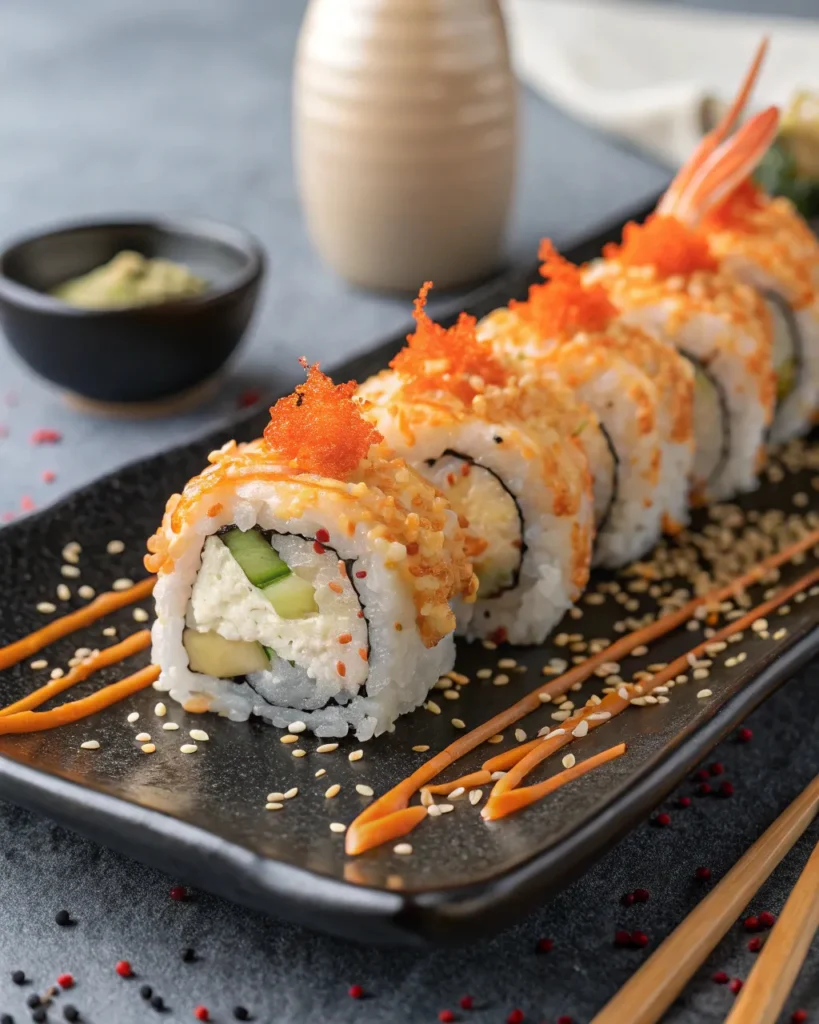
What Are the Tiny Orange Balls on Top of Some Rolls?
If you’ve ever ordered a shrimp tempura roll and noticed tiny, shiny orange spheres sprinkled on top, you’re not alone. These are commonly either masago or tobiko — and yes, they’re edible and intentional.
Here’s a quick breakdown:
| Name | Description | Flavor Profile |
|---|---|---|
| Masago | Capelin fish roe (smaller grains) | Salty, mildly crunchy |
| Tobiko | Flying fish roe (larger, more vibrant) | Slightly smoky, crunchy |
Both types of roe are used to enhance flavor and create an eye-catching look. They also bring a mild ocean-like taste and a satisfying pop when bitten into — making the overall sushi experience more dynamic.
While both are technically raw, they’re cured and pasteurized, making them safe to eat and commonly accepted on cooked rolls.
Other Popular Toppings: Scallions, Tempura Flakes, and Sauce Drizzles
Besides roe, shrimp tempura rolls are often dressed with flavor-boosting toppings and drizzles that create signature variations like the Volcano Roll or Dragon Roll. Here are a few of the most commonly added garnishes:
| Topping | Flavor/Texture Contribution |
|---|---|
| Tempura flakes | Extra crunch and golden finish |
| Spicy mayo | Creamy heat with visual flair |
| Eel sauce (Unagi) | Sweet-savory glaze with umami kick |
| Chopped scallions | Fresh, peppery bite to balance richness |
| Sesame seeds | Nutty aroma and light texture |
These toppings not only elevate taste but also help the roll stand out visually, especially when served as a specialty roll.
Most sushi bars customize the shrimp tempura roll by layering toppings or even torching sauces lightly for added depth — a favorite technique in American sushi fusion.
Eating Etiquette and Presentation
Do You Eat the Tail on Shrimp Tempura Rolls?
This is one of the most debated and frequently Googled questions among new sushi lovers:
Should you eat the shrimp tail on a shrimp tempura roll?
Short answer: Usually not.
In most cases, the tail is left on the shrimp for presentation purposes, especially when served in tempura form. It creates a visual element that looks elegant on the plate and showcases the crispiness of the tempura batter.
However, when the shrimp is used inside a roll, most chefs remove the tail before rolling. If it’s still attached, it’s often sticking out from one end of the roll — creating a dramatic look, but not meant to be eaten.
That said, some people do eat the tail, especially if it’s extra crispy. But unless it’s been specifically fried to a cracker-like consistency, it may be too hard or sharp to chew safely.
How It’s Served in Traditional vs. Modern Sushi Bars
The shrimp tempura roll has a chameleon-like ability to fit into both traditional and modern sushi presentations. Here’s how it differs depending on the style of the sushi bar:
| Style | Characteristics |
|---|---|
| Traditional | Minimal toppings, clean presentation, often tail-removed |
| Modern/Fusion | Loaded with sauces, garnishes, tail-on for dramatic effect |
| Takeout/Quick Service | Compact, sauce on the side, tailored for convenience |
In fusion-focused restaurants, the shrimp tail might stick out of the roll, topped with spicy mayo and sprinkled with tempura flakes or masago. In traditional settings, the tail is often removed, and the roll may come with a delicate brush of sauce instead of a full drizzle.
Presentation aside, the goal is always the same: a balance of visual appeal, flavor, and clean bites. Whether plated as part of an omakase set or wrapped to-go in plastic, the shrimp tempura roll delivers comfort and crunch in every piece.
DIY Shrimp Tempura Roll at Home
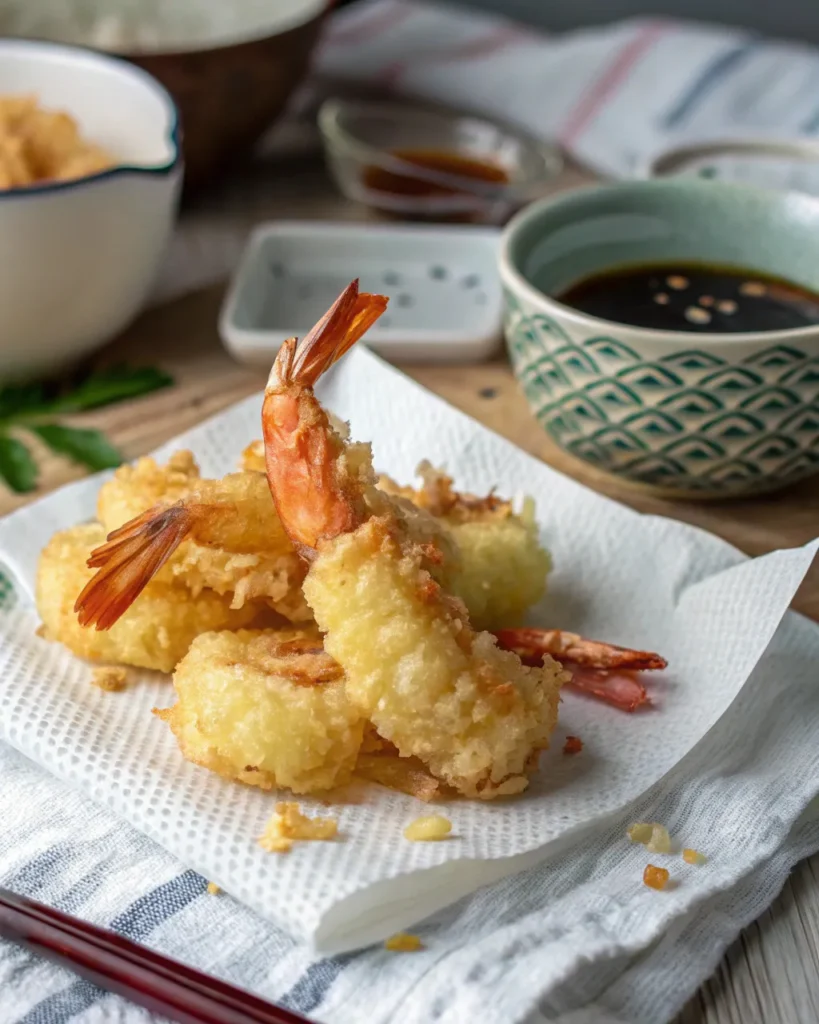
How to Prepare Light, Crispy Tempura Shrimp
If you want to master the shrimp tempura roll, the tempura shrimp itself is your foundation. Unlike heavy Western-style frying, Japanese tempura is all about achieving a light, airy crisp that enhances the shrimp rather than overpowering it.
Here’s a simple breakdown of how to make restaurant-quality tempura shrimp at home:
Ingredients:
- Jumbo shrimp (10–12 pieces, peeled and deveined)
- ½ cup all-purpose flour
- ½ cup cornstarch
- 1 cold egg
- ¾ cup ice-cold water
- Oil for deep frying (canola or vegetable)
Steps:
- Prep the Shrimp: Remove the shell but leave the tail on if desired. Make shallow cuts along the belly to keep the shrimp straight during frying.
- Make the Batter: Mix the egg and ice water. In a separate bowl, mix flour and cornstarch. Combine wet and dry ingredients gently — don’t overmix. Lumps are okay.
- Heat the Oil: Bring oil to 340–360°F (170–180°C).
- Fry the Shrimp: Dip shrimp into dry flour, then into the tempura batter. Fry for 2–3 minutes until golden and crisp. Drain on paper towels.
Pro tip: Keep the batter cold and fry in small batches for best results.
Rolling Techniques and Tools for Beginners
Once your shrimp is perfectly golden, it’s time to roll.
You’ll need:
- Cooked sushi rice (seasoned with rice vinegar)
- Nori sheets (cut in half for easier rolling)
- Bamboo sushi mat (wrapped in plastic)
- Fillings like avocado, cucumber, spicy mayo
- A sharp knife and clean damp towel for slicing
Rolling Steps:
- Lay your nori rough side up on the mat.
- Spread a thin layer of rice, leaving a ½-inch strip at the top for sealing. Sprinkle with sesame seeds if you like.
- Flip the nori (optional) so the rice is on the outside for an inside-out roll.
- Add fillings horizontally — 1–2 tempura shrimp, avocado slices, cucumber strips.
- Use the mat to roll tightly, tucking as you go and gently pressing to shape.
- Seal the edge with a little water and slice with a wet, sharp knife into 6–8 pieces.
Want to go next-level? Top with spicy mayo, eel sauce, or masago before serving.
Variations & Menu Favorites
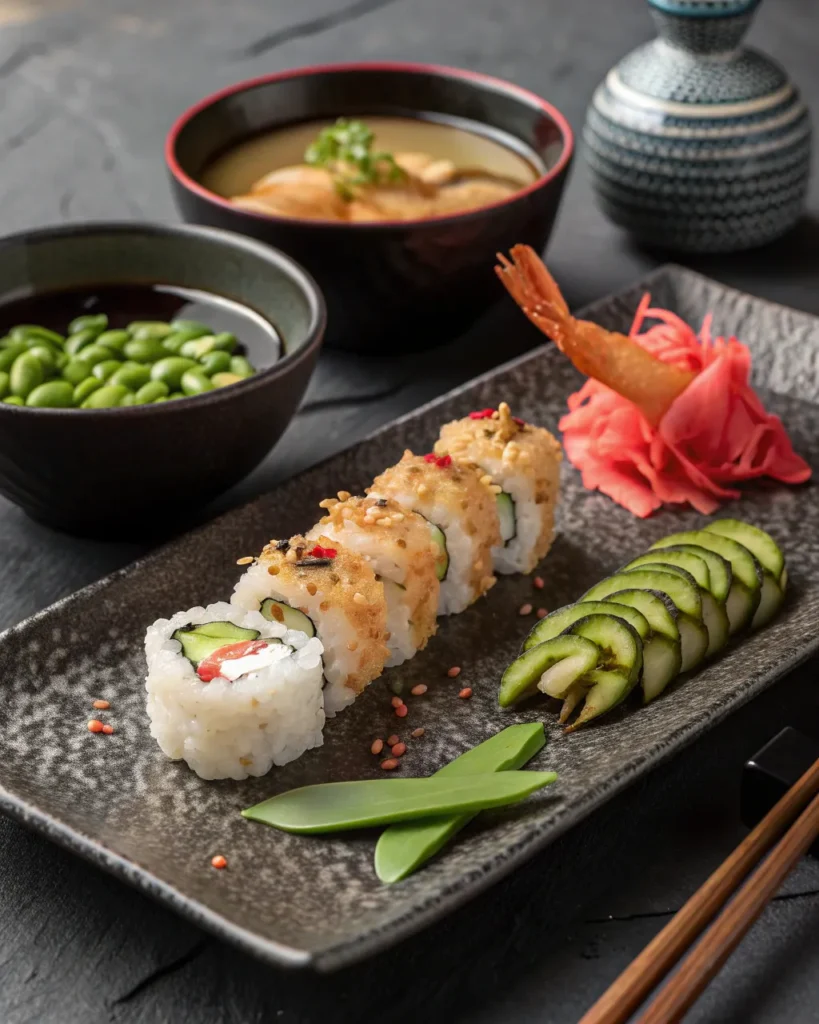
Shrimp Tempura Dragon Rolls, Crunch Rolls, and Specialty Combos
The classic shrimp tempura roll is just the beginning. Sushi chefs across the U.S. have turned this roll into a canvas for innovation, resulting in dozens of flavorful variations that show up on modern sushi menus.
Here are some of the most loved and widely available versions:
| Roll Name | Key Ingredients & Features |
|---|---|
| Dragon Roll | Shrimp tempura, cucumber, topped with avocado and eel sauce |
| Crunch Roll | Shrimp tempura inside, topped with crispy tempura flakes |
| Volcano Roll | Tempura shrimp with spicy crab mix piled on top |
| Firecracker Roll | Jalapeño, spicy mayo, and sriracha for a spicy twist |
| Snow Crab Tempura Roll | Combines tempura shrimp and snow crab, usually torched |
These rolls often use the shrimp tempura base as a starting point, adding toppings, sauces, and bold flavors — discover great ideas like this crunchy roll variation for even more inspiration.
In high-end sushi bars, you may also see these listed under “signature rolls,” where they’re paired with exotic garnishes like mango, yuzu, or even gold leaf.
Creative Pairings: What to Serve with Shrimp Tempura Rolls
A shrimp tempura roll can absolutely shine on its own, but pairing it with the right sides or drinks can take the experience up a notch.
Here’s what goes well:
| Pairing | Why It Works |
|---|---|
| Miso Soup | Warm and savory — a traditional Japanese combo |
| Edamame | Light, salty, and perfect for balancing fried food |
| Seaweed Salad | Refreshing and packed with umami |
| Ginger Green Tea | Cuts through the richness of tempura and sauces |
| Cold Sake or Sparkling Water | Refreshing cleanse between bites |
When plating at home, serve rolls with soy sauce, wasabi, and pickled ginger — not just for taste, but for cleansing your palate between different rolls.
Don’t miss our Grilled Lobster Tail Recipe for an elegant seafood combo that complements sushi night perfectly.
FAQs About Shrimp Tempura Roll
What ingredients are typically included in a shrimp tempura roll?
A classic shrimp tempura roll contains crispy tempura shrimp, seasoned sushi rice, and nori (seaweed). It often includes avocado or cucumber and is topped with sauces like spicy mayo or eel sauce. Some versions also feature masago (fish roe), tempura flakes, or sesame seeds.
Is the shrimp tempura roll safe for those who avoid raw seafood?
Yes. Shrimp tempura is fully cooked before being rolled into sushi. It’s one of the most popular choices for people who prefer cooked sushi or are new to Japanese cuisine.
Why do people consider shrimp tempura rolls a top sushi choice?
The shrimp tempura roll delivers a perfect blend of textures — crispy, creamy, and savory — in every bite. It’s approachable, packed with flavor, and doesn’t involve raw fish, making it an all-time favorite on sushi menus.
What’s the purpose of the small orange fish eggs on top?
Those bright orange balls are either masago (capelin roe) or tobiko (flying fish roe). They add a salty crunch and a burst of umami while enhancing the roll’s presentation.
How is shrimp tempura different from regular fried shrimp?
Tempura is lighter and crispier than typical deep-fried batter. It’s made using a chilled batter of flour, egg, and water, creating an airy texture that complements sushi rather than overpowering it.
Should you remove the tail before eating shrimp tempura sushi?
If the tail is still attached, it’s usually meant for presentation and not to be eaten. In most rolls, chefs remove the tail before rolling. If you see it sticking out, feel free to leave it on the plate.
Conclusion
Whether you’re a sushi beginner or a seasoned fan, the shrimp tempura roll offers a crispy, flavorful gateway into the world of Japanese-American fusion. With its golden-fried shrimp, smooth avocado, sweet-savory sauces, and endless variations, it’s no wonder this roll is a staple in sushi bars everywhere.
Don’t miss our creamy shrimp bisque for another comforting way to enjoy shrimp outside of sushi.
Next time you’re dining out or rolling at home, skip the raw fish and savor the crunch, creaminess, and comfort of this iconic roll.
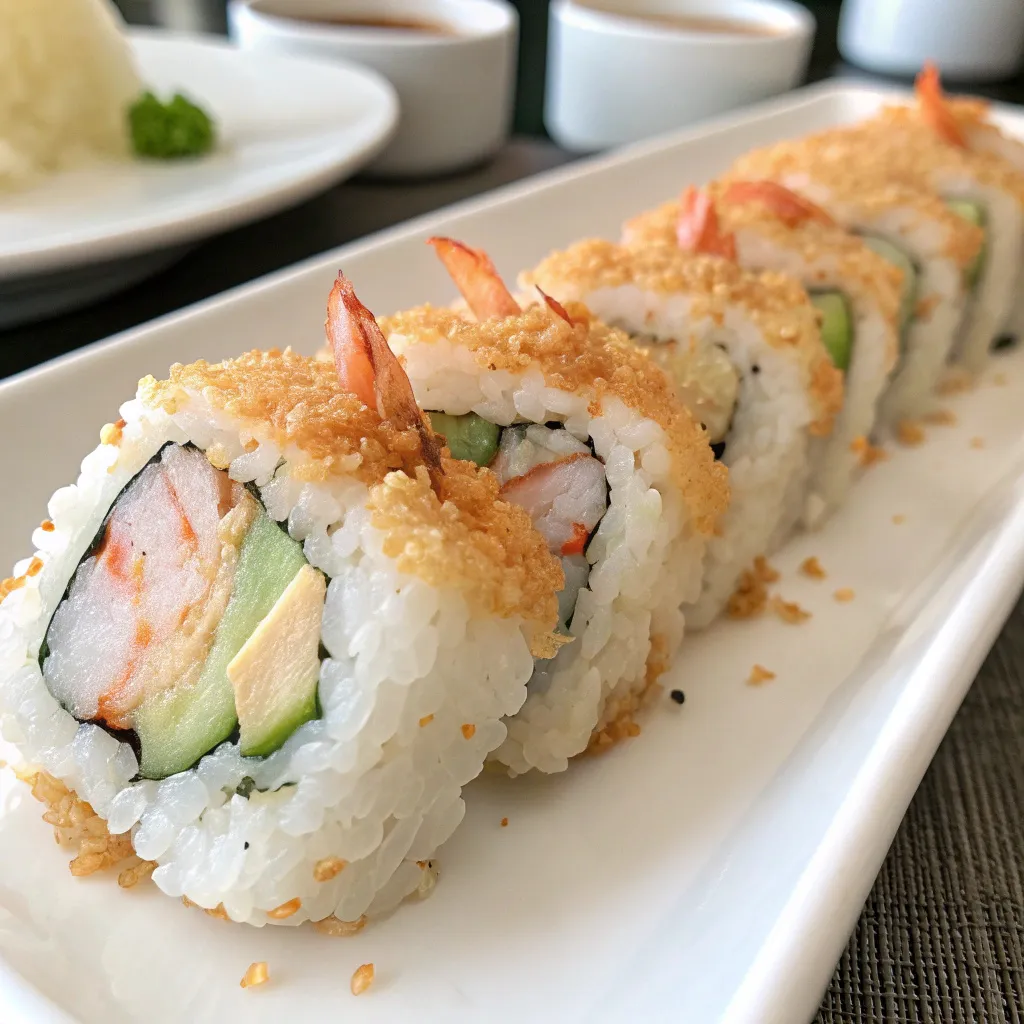
Shrimp Tempura Roll
Ingredients
Equipment
Method
- Make the Tempura Batter: In a bowl, mix flour and cornstarch. In another, beat egg and ice-cold water. Gently combine them to make a lumpy batter.
- Prepare the Shrimp: Lightly dust shrimp with flour, dip into batter, and deep-fry until golden. Set aside to drain.
- Prepare the Rice and Rolling Area: Lay nori on a bamboo mat, rough side up. Spread a thin layer of sushi rice, then flip for inside-out roll (optional).
- Add Fillings: Place tempura shrimp, avocado, and cucumber across the nori.
- Roll the Sushi: Use the mat to roll tightly. Press gently to shape.
- Slice and Serve: Cut into 6–8 pieces with a wet sharp knife. Top with spicy mayo, eel sauce, and masago if desired.
Notes
- You can air-fry the shrimp for a lighter version.
- Keep your hands wet when working with sushi rice to prevent sticking.
- Customize with mango, jalapeño, or cream cheese for variations.
- Tail-on shrimp looks dramatic but is optional.


